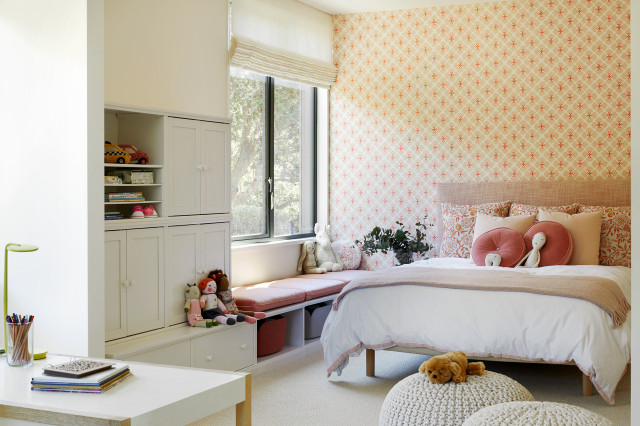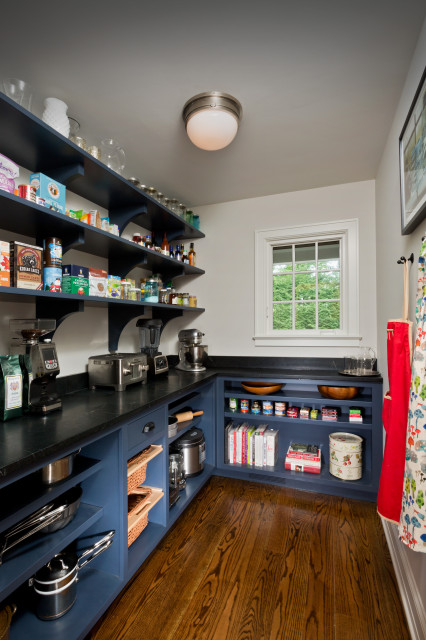

“Smart storage can be as simple as having some beautiful oversize baskets in the corner of your living spaces and kids’ rooms that allow for a quick scoop-up of toys throughout the day,” Deakin says. “Or it could be a storage bench and wall hooks in your entrance or mudroom for shoes, coats, school bags and umbrellas.
“A beautiful sideboard or buffet can make for great storage in a dining or living area.
“On the other end of the scale, you might invest in some custom [cabinetry] with a combination of enclosed storage and open shelving in your living area. Here you might display all your favorite pieces while achieving a beautiful, seamless finish that complements the rest of your home.
“Or you could upgrade to built-in [closet organizers] in the bedrooms. You can customize [them] to suit your family’s specific storage needs and make maximum use of space.”

2. Heated Towel Racks
“One tip that we can’t go past is to put heated towel rails in your bathrooms — hydronic where possible,” says Jasmine McClelland, principal designer at Jasmine McClelland Design. “They are a bit more of an outlay initially than non-heated styles, but they offer so many benefits, particularly for family living.

“The most appealing factor is less work: less washing, less drying. Your towels are warm and fresh when it comes time to use them, as is your bath mat,” McClelland says. “This is a lifesaver and such a luxury, particularly when you have kids and feel like you’re constantly washing everything.
“It also means your towels can be folded neatly and there will be less moisture and dampness in your bathroom. Your space will look sharp and smell fresh, which is so important — especially when guests are coming over.
“An added bonus is a toasty warm bathroom on those freezing cold mornings. A heated towel rail truly is a game changer.”

3. A Plan for the Future
“Keep in mind that children grow into full-size adults,” says Sophie Kost, interior designer and principal at My Beautiful Abode. “When you are planning a renovation or new build with small children, consider how spaces will be used in years to come.
“The number of homes I’ve been to with second-story additions that have low ceilings, small rooms suited to single beds and minimal storage always surprises me.

“These rooms become a problem when the kids outgrow the single bed and there is no room to squeeze in a queen bed, or the sweet desk that was perfect for primary school coloring in is now inappropriate for final school exams or university textbooks,” Kost says. “That collection of giant skater-basketball-dance shoes may no longer have a space in the small closet either.
“When planning children’s rooms, aim for a [13-by-13-foot] floor area to future-proof the room. And if you can extend the budget, push the ceiling up from the minimum for a bit more headroom.”

4. Walk-In Pantry
“I believe a walk-in pantry is a must-have in the kitchen of a busy family home,” says Anoushka Allum, interior designer and principal at Anoushka Allum Design.
“With more of us having open-plan living areas, the kitchen is front and center. A walk-in pantry helps keep the main kitchen tidy — you can store all your small appliances here and do food preparation when you’re entertaining.

“If the walk in-pantry I’m designing has the space, I’ll include a sink, dishwasher drawer or full dishwasher, plenty of open storage and closed storage in the area that can be seen from the door when it’s open,” Allum says.
“Drawers to store food items are key. They keep everything neatly stored away and items are easy to access, particularly when you’re in a rush.
“A walk-in pantry isn’t just about food storage these days. It’s a space to make drinks, snacks and prepare dishes when we’re entertaining. For this reason I always try to include counter space to accommodate small appliances, such as kettles and toasters, and to do food-preparation work.”

5. Comfort
“Comfort is key in a family home — particularly when it comes to pieces such as sofas where you’ll probably spend a lot of time over the years,” says Camilla Molders,
interior designer and principal at Camilla Molders Design.
“Everyone’s idea of comfort is different, so in my view it’s worth going to the expense of having pieces custom-designed so they’re right for you. For example, you may want to have the sofas in your family room or living area custom-made to suit your unique proportions and desired comfort level.
“With a custom sofa, you can shorten the seat, alter the height of the legs, change the cushion fill and even dictate how the piece is upholstered; for example, with feature piping or special detailing.

“Dining chairs are another area where you should prioritize comfort to make for enjoyable family dinners and entertaining,” Molders says.
“Wood cafe-style chairs might look great; however, they are designed to keep you moving on and not for lingering. For family meals, I would recommend upholstered styles with comfortable seating.”

6. Lighting
“Good lighting encompasses everything from orientation, windows, skylights and color to artificial lighting,” says Giulianna del Popolo, interior designer and principal at GDP Interior Design. “Light affects everything from the aesthetic, mood and functionality of a home to indoor temperature.
“Just like the weather affects our mood, so does the amount and quality of light we receive in our living spaces. During the day, natural light can transform a room, depending on the orientation and window size. Likewise, a colder light can make you feel less cozy or even gloomy. It isn’t always an option to have favorable orientation, so the best way to remedy gloomy spaces is to have considered light sources, whether that is general ambient light, task lighting or mood lighting.
“In conjunction with lighting, paint finishes and color selections are key to accentuating the required light and mood of a room.

“There’s so much to consider when it comes to lighting, so it’s best to consult an interior designer or lighting designer in order to get it right,” del Popolo says. “This should ideally be done pre-build, at the same time as your plans are being put into place, to allow for all the necessary wiring to be roughed in, switch points to be considered and light fittings and globes to be specified.
“Your designer will be able to interpret your room orientation, window and skylight sizes to determine how much lighting you require in a room, the quality of light (warm or cool) and how you can add special effects fit for purpose.”

7. Space Planning
“The living or family room is one of the most important spaces within a family home — it tends to be where everyone gathers and a lot of different activities are performed, from watching movies and socializing to quiet times,” says Gary Hamer, interior designer and principal at Gary Hamer Interior Design. “As such, it’s crucial to furnish the space appropriately.
“Space planning is key. It helps you work out exactly what furniture you’ll need and which sizes and shapes will work best in the space. It surprises me how many times clients purchase a sofa or dining table that looked great in the showroom, only to find it’s way too big for their living room.

“Before furnishing the room, consider what you and your family do there and make sure there is enough appropriate seating and surface space to put down a plate, a pile of books or a drink,” Hamer says. “Draw a floor plan to scale to work out whether furniture will fit — and remember to include some breathing space around each piece and ensure furniture doesn’t block doorways or traffic flow.
“You want everyone in your family to feel calm, safe and uplifted in the space. When you’re creating the space plan, imagine the flow of air through your space as water. You need to create a slow, gentle flow that promotes calm. It might be a sofa with a curvy corner to balance square edges elsewhere or a round coffee table or ottoman to promote an easier flow around a living room.”

8. Personality
“We always encourage clients with families to surround themselves with the colors, pieces and features they love rather than slavishly following trends,” says Jacquie Pask, interior designer at Moss Melbourne. “This way you’ll create a home that has personal meaning to you, which you’ll enjoy spending time in.
“Bring cherished items and pieces of family history into the design — this is, after all, what will make your family home uniquely your own.”

9. Multifunctional Spaces
“Zoned rooms and spaces that can be used for different purposes are an essential in a family home, providing opportunities for both togetherness and privacy,” says Frances Cosway, design director at White Pebble Interiors.
“Ideally, you want a mix of communal spaces, where the family can come together and connect, and separate spaces or rooms away from the main family hub, where individuals can retreat for privacy or to pursue their own activities, such as reading, relaxing or music practice.

“Multifunctional spaces — or ones that can be used for different purposes — are a boon in a family home,” Cosway says. “For example, having a second living area where the adults can retreat to in the evenings that can also be used as a quiet place to read, sew or knit during the day. Or a teenager’s retreat where your child can hang out with their friends and play games, which can be shut off at other times and used as a quiet space for study.
“The key with multifunctional rooms is that they can be closed off to create a true sense of privacy and quiet away from the busy or noisy parts of the home.”


1. Adequate Storage
“Storage is so important in a family home,” says Jessi Deakin, stylist and owner of Jessi Eve Interiors. “A shortage of storage can mean clutter, chaos and disorganization as you navigate toys, school bags and books, sporting equipment and everything else that comes along with family living.
“Practical storage helps you create organizational systems so clutter doesn’t build up on surfaces and in the corners of rooms. It’s the key to maintaining some level of serenity in a family home.